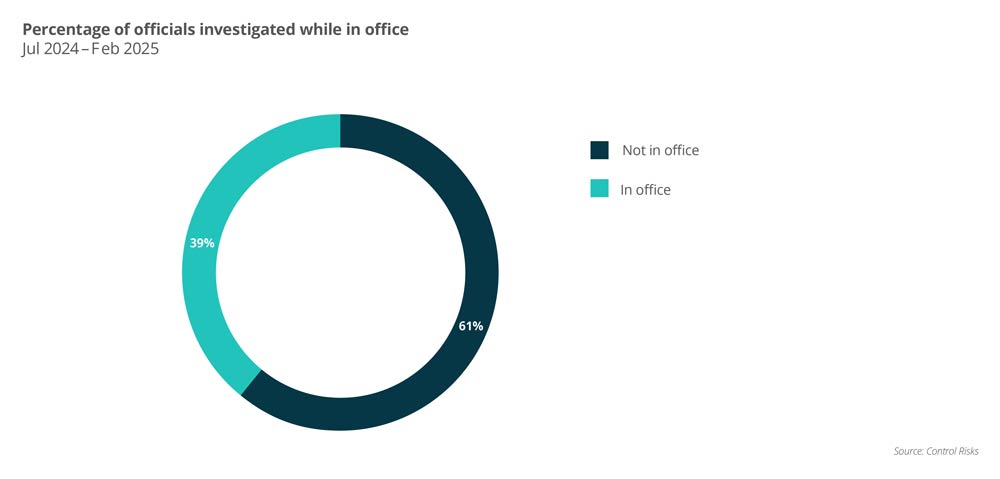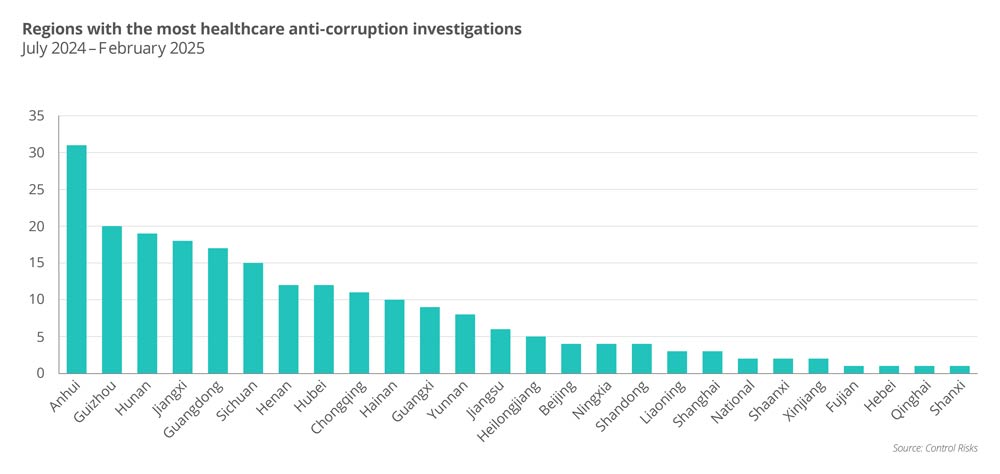Built Environment & Infrastructure Risk Management
-
Search
This article is based on content originally published on our partner platform, Seerist, the augmented analytics solution for threat and risk intelligence professionals.
China launched a sweeping national campaign against healthcare corruption in mid-2023, marking a major escalation of anti-corruption enforcement in the sector. The campaign has gained new momentum in 2024-25, with intensified regulatory efforts from various authorities and evolving compliance expectations for healthcare businesses.
Among the most important regulatory changes in early 2025, the State Administration for Market Regulation (SAMR) released the “Compliance Guidelines for Healthcare Companies to Prevent Commercial Bribery Risks” on 10 January. What are the evolving enforcement trends in China’s healthcare industry in 2025, and what are the implications of these changes for business?
The SAMR guidelines came with the healthcare sector remaining a priority target of anti-corruption enforcement. The nationwide healthcare anti-corruption campaign, launched in July 2023, was initially set to last one year. However, it continued through 2024, likely indicating central regulators' perception that corruption-related violations remained prevalent. According to state media, at least 350 healthcare officials were the subject of new investigations in 2024. The Central Commission for Discipline Inspection (CCDI) in January 2025 reaffirmed healthcare as one of eight “key anti-corruption fields” for the year, underscoring ongoing and heightened regulatory scrutiny over the sector.
While malfeasance by healthcare officials continues to be the primary focus, there have been tangible business implications from these widespread investigations. Several leading multinational healthcare companies have cited delays to procurement tenders and product deliveries due to the campaign in their latest financial reports – for example, due to precautionary measures by local health institutions during investigations into relevant officials. Moreover, investigators' attention has steadily turned toward business personnel involved in bribery schemes. Public records indicate that at least five senior executives from listed domestic healthcare companies were detained for corruption-related investigations in the second half of 2024, reflecting increased regulatory action against bribe-givers.
Control Risks identified 221 publicised cases of new anti-corruption investigations into senior local healthcare officials across the country between July 2024 and February 2025, which revealed some shifting enforcement priorities and expanding areas of scrutiny. For example, early 2025 has indicated an emerging trend of more investigations into national-level healthcare officials. A former vice director of the National Medical Products Administration (NMPA) was detained for CCDI investigations in late February 2025, making him the most senior healthcare official affected by the anti-corruption campaign so far. Media reports in January also indicated that the National Joint Procurement Office for High-value Medical Consumables director was subject to corruption-related investigations.
As seen since the campaign began in mid-2023, public hospital heads and department chiefs responsible for medical procurement remain the most frequent targets of investigations. However, unlike the period from 2023 to early 2024, regulators have been increasingly scrutinising senior officials at local healthcare authorities involved in volume-based procurement (VPB) programmes, product testing and approvals, and public health insurance management.
Additionally, there has been a rise in cases involving senior executives at state-owned enterprises (SOEs) in the healthcare sector and leaders of medical-focused higher education institutions. These developments suggest that the scope of enforcement is broadening, requiring businesses to monitor not only interactions with hospitals but also engagements with other state-affiliated stakeholders across the product lifecycle, including approvals and distribution.

Another trend is the retrospective nature of enforcement. Approximately 60% of the 172 investigations in the past eight months involved healthcare officials who were retired or had been transferred to other positions. In comparison, investigations at the beginning of the campaign predominantly targeted incumbent local healthcare officials, as indicated by public records. Many of these cases could be traced back to violations in the 2010s, underscoring the importance for businesses to conduct thorough reviews of their legacy compliance practices to prevent any potential exposure to regulatory scrutiny.

There also continued to be clear regional disparities in anti-corruption enforcement. Anhui emerged as the province with the highest number of investigations in the past eight months, followed by Guizhou, Hunan and Jiangxi. These regions were also hotspots in 2023, suggesting a sustained focus by regulators. Many of these investigations have been driven by the “chain effect”, where probes into one senior official lead to scrutiny of their subordinates and sometimes close business contacts. Businesses operating in these regions should strengthen local compliance measures and monitor future enforcement rollouts tied to previous or ongoing investigations.

The SAMR guidelines align with existing anti-bribery regulatory frameworks by the Anti-Unfair Competition Law as well as regulations issued by other authorities. Besides reflecting the rising compliance expectations for healthcare companies, the guidelines also aim to provide practical and standardised instructions to address areas of ambiguity, such as medical representatives’ interactions with doctors and companies’ donations for academic research.
For the first time, the guidelines identified nine “high-risk” scenarios in healthcare companies’ business and academic activities in China. Each scenario has specific “dos and don’ts” and prohibited activities. Aside from the already heightened scrutiny of medical representatives’ engagement with doctors, the guidelines emphasise the need for businesses to strengthen the compliance management of their third-party vendors during stages such as production distribution and clinical research.
Notably, the SAMR, through the guidelines, has outlined how companies with violations can reduce penalties by cooperating with investigators, such as by proactively self-reporting violations or providing evidence of misconduct. This aligns with Beijing’s baseline message since 2023, which is that the enforcement campaign aims to improve the industry’s overall compliance rather than punish all businesses with prior violations.
Businesses are advised to review and align their compliance protocols with the recommended measures for all relevant scenarios from the guidelines. The SAMR and its regional branches will likely use the guidelines as benchmarks in future investigations to assess whether certain anti-bribery violations were due to individual misconduct or insufficient compliance management by companies at an organisational level.
| Scenarios with bribery risk exposure | Examples of risk activities flagged by SAMR |
|---|---|
| Academic visits and promotional activities at hospitals | Assigning sales targets to medical representatives and encouraging them to interfere in doctors' prescription decisions |
| Hosting healthcare workers at business activities |
Concealing hosting costs under other expense categories (for example, training or research) |
| Paying doctors for expert consulting services | Lack of transparency in service scope, frequency or payment standards |
| Outsourcing production, research and development, distribution to third parties | Paying outsourced service providers excessively or without sufficient justification |
| Providing discounts or commissions during sales | Providing unrecorded or excessive discounts, rebates, or commissions to distributors or third parties |
| Donating funds or medical products | Using donations or sponsorships to influence procurement decisions, bypass competitive bidding or gain preferential treatment |
| Placing free medical equipment at hospitals | Offering free medical equipment to hospitals in exchange for exclusive procurement agreements |
| Partnering with hospitals for clinical research | Payments or incentives provided to accelerate research timelines or manipulate results |
Source: State Administration for Market Regulation
Beyond anti-bribery, regulatory pressure is also rising in other areas of healthcare compliance, including bidding-related compliance, public health insurance, and product quality. These areas require more proactive internal controls and regulatory monitoring to mitigate risk exposures. It is also critical for businesses to strengthen compliance tracking and raise awareness for their third-party vendors and other external partners.